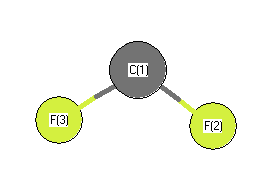Jump to
S2C1
Energy calculated at QCISD/6-311G*
| | hartrees |
|---|
| Energy at 0K | -237.261175 |
| Energy at 298.15K | -237.260958 |
| HF Energy | -236.723694 |
| Nuclear repulsion energy | 64.667190 |
The energy at 298.15K was derived from the energy at 0K
and an integrated heat capacity that used the calculated vibrational frequencies.
Geometric Data calculated at QCISD/6-311G*
Point Group is C2v
Cartesians (Å)
| Atom |
x (Å) |
y (Å) |
z (Å) |
|---|
| C1 |
0.000 |
0.000 |
0.596 |
| F2 |
0.000 |
1.031 |
-0.199 |
| F3 |
0.000 |
-1.031 |
-0.199 |
Atom - Atom Distances (Å)
| |
C1 |
F2 |
F3 |
| C1 | | 1.3023 | 1.3023 |
F2 | 1.3023 | | 2.0626 | F3 | 1.3023 | 2.0626 | |
 More geometry information
More geometry information
Calculated Bond Angles
| atom1 |
atom2 |
atom3 |
angle |
|
atom1 |
atom2 |
atom3 |
angle |
| F2 |
C1 |
F3 |
104.729 |
|
Electronic energy levels
Electronic state
Charges, Dipole, Quadrupole and Polarizability
Jump to
S1C1
Energy calculated at QCISD/6-311G*
| | hartrees |
|---|
| Energy at 0K | -237.176476 |
| Energy at 298.15K | -237.176170 |
| Nuclear repulsion energy | 62.198711 |
The energy at 298.15K was derived from the energy at 0K
and an integrated heat capacity that used the calculated vibrational frequencies.
Geometric Data calculated at QCISD/6-311G*
Point Group is C2v
Cartesians (Å)
| Atom |
x (Å) |
y (Å) |
z (Å) |
|---|
| C1 |
0.000 |
0.000 |
0.498 |
| F2 |
0.000 |
1.138 |
-0.166 |
| F3 |
0.000 |
-1.138 |
-0.166 |
Atom - Atom Distances (Å)
| |
C1 |
F2 |
F3 |
| C1 | | 1.3178 | 1.3178 |
F2 | 1.3178 | | 2.2765 | F3 | 1.3178 | 2.2765 | |
 More geometry information
More geometry information
Calculated Bond Angles
| atom1 |
atom2 |
atom3 |
angle |
|
atom1 |
atom2 |
atom3 |
angle |
| F2 |
C1 |
F3 |
119.483 |
|
Electronic energy levels
Electronic state
Charges, Dipole, Quadrupole and Polarizability
